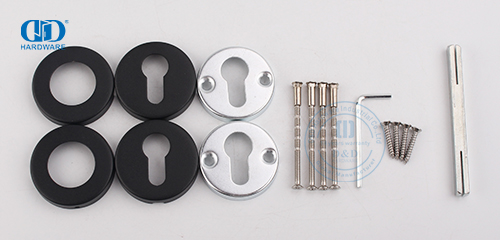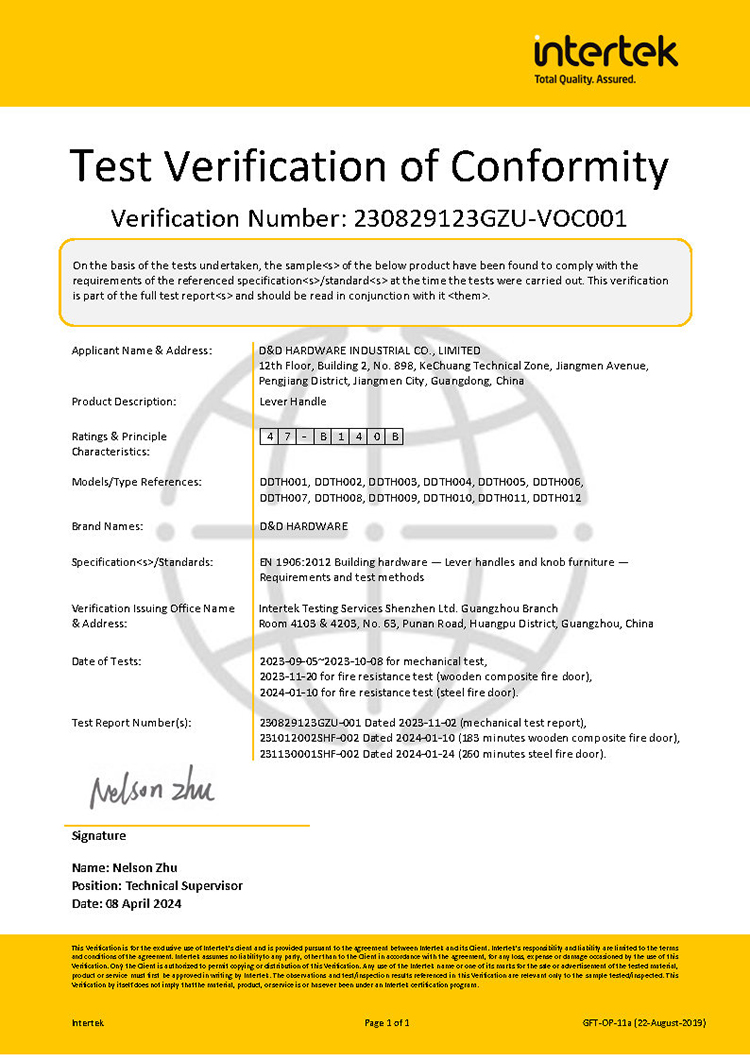Get Famous Branded Quality at Factory Cost
Pls inquire to sales@danddhardware.com
\\: +86 139 2903 7292
Author: Site Editor Publish Time: 2025-08-15 Origin: Site







Nothing frustrates homeowners more than a wobbly door handle that threatens to fall off at the worst possible moment. Whether you're dealing with a loose handle on your front door or a bathroom knob that keeps spinning freely, the culprit is often a missing or incorrectly sized set screw. Understanding what size set screw your door handle needs can save you time, money, and the embarrassment of a handle that comes off in your guests' hands.
Set screws are small but mighty components that secure your door handle to its shaft, preventing it from sliding or rotating when not intended. Getting the right size isn't just about functionality—it's about ensuring your door operates smoothly and safely for years to come. This guide will walk you through everything you need to know about identifying, measuring, and replacing set screws for various types of door handles.
A set screw is a threaded fastener that secures your door handle to the spindle or shaft that runs through your door. Unlike regular screws that thread into pre-made holes, set screws typically press against or thread into the shaft itself, creating a tight connection that prevents the handle from moving independently.
Most door handles use set screws as their primary attachment method because they're reliable, relatively inexpensive, and easy to replace when necessary. The set screw sits in a small hole on the neck of the door handle, usually accessible from the side or bottom of the handle assembly.
Door handles typically use one of three set screw types:
Cup point set screws feature a cone-shaped depression at the tip that grips onto the shaft. These are the most common type found in residential door handles because they provide excellent holding power while being forgiving during installation.
Flat point set screws have a flat tip that presses directly against the shaft surface. These work well on shafts with flat surfaces or small indentations designed to accept them.
Cone point set screws have a sharp, pointed tip that can dig into softer metals. While they provide strong holding power, they can damage the shaft if over-tightened.
Most residential door handles use set screws ranging from #6 to #10 in diameter, with lengths typically between 1/4 inch and 1/2 inch. However, the exact size depends on several factors including the handle style, manufacturer, and intended use.
The most common set screw sizes for standard residential door handles are:
· #8-32 x 3/8 inch: This size fits most standard lever-style door handles and many round knobs. The #8 refers to the screw diameter, 32 indicates threads per inch, and 3/8 inch is the length.
· #10-24 x 1/4 inch: Often found in heavier door handles or commercial-grade hardware where additional strength is needed.
· #6-32 x 5/16 inch: Common in lighter-weight door handles and some decorative hardware.

Commercial door handles and heavy-duty residential hardware often use larger set screws to handle increased wear and stress:
· 1/4-20 x 3/8 inch: Found in commercial lever handles and high-traffic applications
· #10-32 x 1/2 inch: Used in heavy-duty residential and light commercial hardware
Measuring your set screw correctly ensures you get the right replacement. You'll need to determine three key measurements: diameter, thread pitch, and length.
· Small ruler or measuring tape
· Thread pitch gauge (optional but helpful)
· Flashlight or good lighting
· Small screwdriver or Allen wrench for removal
Step 1: Remove the existing set screw if possible. Use the appropriate screwdriver or Allen wrench to carefully unscrew it. If the screw is damaged or stripped, you may need to use pliers or a screw extractor.
Step 2: Measure the diameter. Use a ruler to measure across the widest part of the screw threads. Compare this measurement to standard screw sizes—#6 screws are approximately 0.138 inches, #8 screws are 0.164 inches, and #10 screws are 0.190 inches.
Step 3: Determine thread pitch. Count the number of threads in one inch of the screw, or use a thread pitch gauge for accuracy. Common pitches are 24, 28, and 32 threads per inch.
Step 4: Measure the length. Measure from the tip of the screw to the bottom of the head. This should match the thickness of your door handle neck plus enough length to engage the shaft properly.
If the set screw is too damaged to remove easily, you can still get measurements. Use a small ruler to measure the visible diameter of the screw head. Look for any markings on the door handle or manufacturer information that might indicate the hardware specifications.
Once you have your measurements, finding the right replacement becomes straightforward. However, there are several places to look and factors to consider.
Hardware stores are your first stop for common sizes. Most carry standard door handle set screws in popular sizes. Bring your old screw or measurements to ensure you get the right match.
Online retailers offer the widest selection, including hard-to-find sizes and specialty screws. This is often your best bet for commercial or unusual residential hardware.
Door hardware specialists can provide expert advice and often carry professional-grade set screws that last longer than standard hardware store options.
The original manufacturer should be contacted for vintage or specialty door handles where standard sizes don't work.
Most door handle set screws are made from steel, but the finish and treatment matter for longevity:
· Stainless steel resists corrosion and works well in all environments
· Zinc-plated steel offers good corrosion resistance at a lower cost
· Brass matches brass door hardware and resists corrosion naturally
· Black oxide provides a dark finish that hides well in most applications
Proper installation ensures your door handle stays secure and functions smoothly. Even with the correct size set screw, poor installation can lead to problems.
Start by ensuring the door handle shaft is clean and free from debris or old thread-locking compound. Position the handle where you want it, making sure any alignment marks or flat spots on the shaft align with the set screw hole.
Insert the set screw and hand-tighten it first. This prevents cross-threading and ensures proper alignment. Once hand-tight, use your screwdriver or Allen wrench to tighten the screw snugly against the shaft.
Avoid over-tightening, which can strip the threads or damage the shaft. The screw should be tight enough that the handle doesn't move, but not so tight that you risk damage.
Apply a small amount of thread-locking compound to set screws in high-use applications. This prevents them from loosening over time while still allowing future removal.
Check set screws periodically, especially on frequently used doors. A quick tightening every few months can prevent handle loosening and the need for more extensive repairs.
Consider upgrading to higher-quality set screws if you frequently experience loosening. Better materials and manufacturing can provide longer service life.
Even with the right size set screw, you might encounter problems during replacement or installation.
If the set screw hole threads are damaged, you may need to drill and tap for a larger screw size. Alternatively, thread repair inserts can restore the original size threads.
A shaft that's been damaged by over-tightened set screws might need filing or sanding to create a new flat spot for the screw to grip.
If your handle remains loose despite a properly sized and tightened set screw, check for wear in the handle bore or shaft. Excessive wear might require handle replacement.
Getting the right size set screw is just the beginning. Proper maintenance and quality components ensure your repair stands the test of time.
Regular maintenance, quality replacement parts, and proper installation techniques will keep your door handles functioning smoothly for years. When in doubt, consult with hardware professionals or consider upgrading to commercial-grade components for heavily used doors.
Remember that door handle repair is often more cost-effective than replacement, especially when you use the right size components and follow proper installation procedures. With this knowledge, you can confidently tackle door handle set screw replacement and keep your doors operating safely and smoothly.
D&D BS EN Door Handle: BS EN1906 300,000 cycles test, EN1634 Fire Rated 183/260mins, EN1670 Corrosion Resistance 240 hours.

Click here for additional details on door handles.
Now contact us.
Contact information for David Jian
Contact number: 0086-139 2903 7292
Email address: sales@danddhardware.com